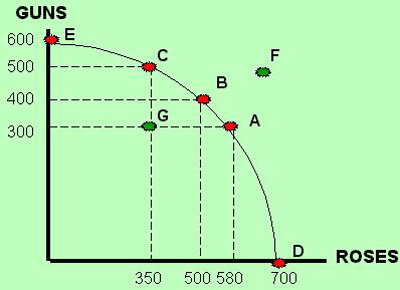Introduction
An economy can't produce an unlimited number of goods and services since there are finite quantities of each factor of production. The graph of an economy's production possibilities curve shows the numerous possible combinations of goods and services that can be created. Below is a visual representation of the production options framework for your convenience. We will make the assumptions that there are only two products that can be produced in this economy, that the quantities of the production factors and the technology we have access to are constant, and that there are no other possibilities to construct the production possibilities curve. learn what is the production possibilities curve in economics.
A description of the behaviour of the production capability curve
The production possibility curve illustrates the expenses in a society's decision to select one of two goods. An economy achieves the best possible quality of living when it is situated at the very end of this curve. It is also known as the production possibility frontier because it creates as much as possible with its resources. When production falls below the curve's upper limit, not all available resources are used—position E on the previously displayed diagram.
A time of economic contraction, such as a recession or depression, is one potential cause of this inefficiency. There won't be enough demand for either product if that happens. There could also be layoffs, which would decrease the available staff and, consequently, the output.
There are more complicated reasons for industrial inefficiency as well. A nation's economy will stagnate if it does not use its comparative advantage. In some locations, such as Florida for oranges and Oregon for apples, certain produce varieties perform better than others due to the local climate. The fruit and vegetable industry benefits from comparative advantages in both Florida and Oregon. Growing apples rather than oranges in Florida would be a waste of resources. The U.S. quality of living would drop if the economy continued on its current course.
Furthermore, the manufacturing feasibility curve cannot be deviated from in any way. We cannot boost the production of either product because of resource limitations. The graph is shown above, position F.
The curve of Potential Production and its General Structure

The output curve has a form that slopes outward, demonstrating the system's potential output. You will be at the highest point on the curve if you can only complete one calculation correctly (on the y-axis) but none of the others (on the x-axis). There is a total production of zero other varieties of fruit in the economy of Point A, even though it produces 140,000 apples.
At its widest point, the graph generates the most significant amount of goodness along the x-axis, while the y-axis generates the least amount of goodness possible. This particular point on the graph is associated with the meaning of the letter "D." Instead of apples, the culture is responsible for producing forty thousand oranges.
Every value between those two extremes represents a compromise between the two characteristics. Having the right proportion of different types of goods and services is essential to the successful operation of any economy. The inability of the resource to be used effectively in the production of a wide variety of goods is the root cause of this problem. Some locations are ideal for the cultivation of apples, while others are more suited to the cultivation of oranges. The most beneficial social results can be achieved by cultivating different resources for the proper functions. The production possibility curve will begin to flatten and become more skewed as resources become increasingly specialised.
What changes in the production possibility curve are reflected in the economy?

The trade-off curve doesn't advise policymakers on how much of each good the economy should produce; instead, it shows how much of one item must be sacrificed to increase the output of the other. As a result, decision-makers in government are better informed. They are free to decide what constitutes the ideal range at all times. The "law of demand" governs the production levels for particular goods in a free market economy. In a command economy, planners are responsible for determining the ideal level of productivity. They'll probably come up with a variety of ideas for how to hire more workers.
Conclusion:
As its name suggests, the production possibilities curve shows the different volume combinations that can be obtained while manufacturing two things with a specific set of fixed resources. According to the hypothesis, as one good's output increases, so will the output of another. There will be production points inside the curve if an economy is not producing at its comparative advantage. The production possibilities curve can be used to determine the proper quantities in which goods should be produced.











